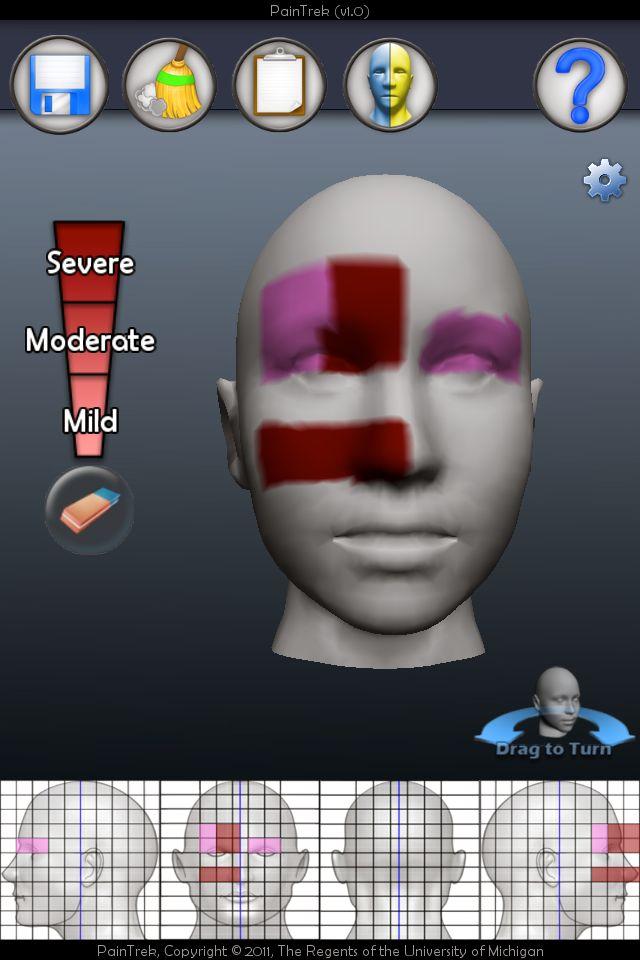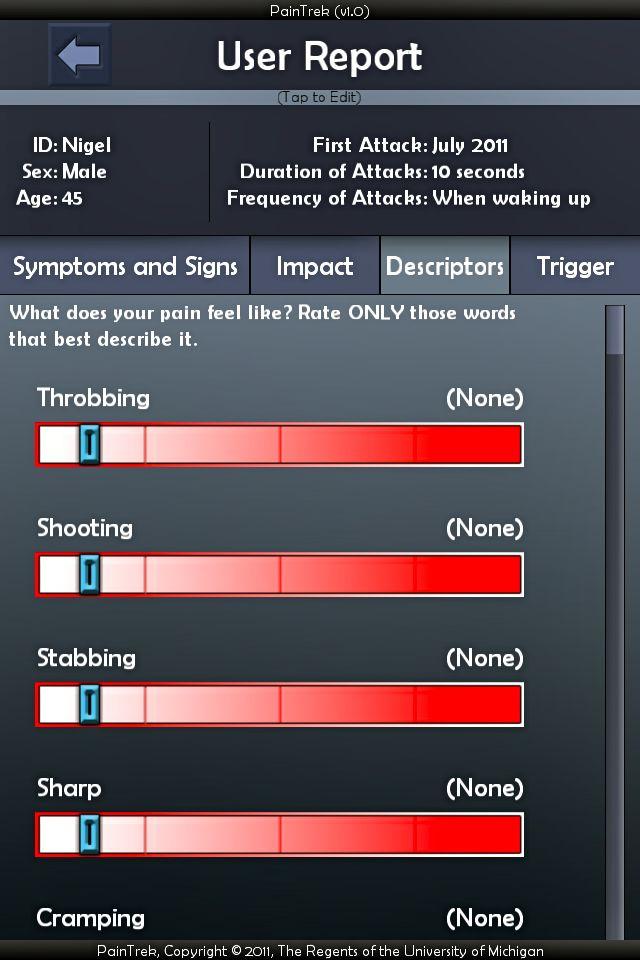Migraine Pain App Wins 1st Place in U-M Tech Challenge6 min read
Ann Arbor, MI — February 7, 2013 — A pain application that allows persons suffering from migraine headaches and facial pain to precisely record the location of the pain in real time on an iPhone or iPad, as well as quantify the intensity and impact of the pain, has won first prize in a University of Michigan Mobile Apps Challenge.

The free application, PainTrek, was developed by Dr. Alexandre DaSilva, director of the School of Dentistry’s Headache and Orofacial Pain Effort (HOPE), who collaborated with a team with the University’s 3D Lab.
The PainTrek app has a menu that allows patients to describe the intensity of the pain, how the pain is affecting their lives, what triggers the pain, and other symptoms, such as nausea. The patient’s information is recorded, tracked, and analyzed so the pain can be more effectively treated and a clinician can develop a long-term pain management plan.

“For 15 years I have been working to try to better understand the mechanisms in the brain that trigger headaches and facial pain disorders,” DaSilva said. “However, equally important is being able to apply these mechanisms clinically so patients and doctors can monitor, in real time, what is occurring and any of the nuances about these pains.”
Critical Criteria
Fifteen years of research and advances in technology converged three years ago when DaSilva came up with the PainTrekconcept. Working with Eric Maslowski, director of the University of Michigan 3D Laboratory and other members of his team, DaSilva said some fundamental features were critical in developing the application.
“It had to help the patient, be mobile, simple to use, intuitive, and clinically relevant,” DaSilva said. “We also wanted this application to be one they would not hesitate to use again and again if further migraine headaches or other orofacial pains occurred.”
How it Works
Taking advantage of touch screen technology, the app launches a three-dimensional model of the head with vertical and horizontal coordinates superimposed over anatomical landmarks. Similar to geographical coordinates on a map, the individual touches the location on the screen to pinpoint the location of the pain and rate its intensity.

The app also has a series of questions about the signs and symptoms associated with the pain, the impact the pain is having on their life, a description of the pain (throbbing, shooting, stabbing, sharp, etc.) and what may have triggered it. The data is then stored giving both the patient and clinician a wealth of information that can be used for clinical treatment or for research purposes.

“Even though recording data associated with the pain is simple, the information provided to a clinician or researcher is very detailed and timely,” DaSilva said. “Because it’s historical in nature the data helps the patient and clinician determine if there are any cause-and-effect type relationships where an action may trigger a pain.”
Clinicians Comment
Dr. Wade Cooper, director of the U-M Headache and Neuropathic Pain Program and an assistant professor in the Medical School’s Departments of Neurology and Anesthesiology, was excited when he saw the PainTrek app for the first time.
Cooper said he was intrigued with finding a way to use technology so patients could pinpoint the location of their pain and its level of intensity. “The level of precision with PainTrek is tremendous. There’s an unmistakable ‘Wow Factor’ to it because it not only allows one to precisely locate where the pain is occurring and how intense the pain is, but it’s also incredibly easy to use.”
Before PainTrek, patients with migraine headaches or similar pains would record their pains and everything about them in a journal and later discuss the information with their physician. But PainTrek changes that, he said, “because now all of that can be done in real time which can help us develop treatment plans for patients, especially those who have a long history of migraine headaches or similar pains.”
Cooper believes the PainTrek application will appeal to those between the ages of 20 and 40 who are most susceptible to chronic pain. “This age group is already technologically savvy, so I think the app will be one they will want to have ready to use when the time comes.” As more use PainTrek, Cooper believes clinicians and researchers worldwide may be able to enhance their collaborations and discover answers to questions about pains in the orofacial region.
About 200 patients a month are treated at the U-M pain clinic. About one-third of them are new patients, according to Cooper. In this group, he said, between one-fourth and one-third of the patients may want to use the app.
Another clinician involved is Dr. Parag Patil, an assistant professor of neurosurgery, anesthesiology, and neurology at the U-M Medical School.
“PainTrek is a wonderful tool for patients because it is both precise and interactive,” he said. “If, as they say, ‘a picture is worth a thousand words,’ then PainTrek has even more value because patients with facial pain or those suffering from migraine headaches can precisely record the location of their pain, its intensity, and even its characteristics. That level of precision is unprecedented and will be very useful.”
Patil said the information from patients who use the app would enable him and other clinicians to not only analyze and keep a record of a patient’s pain experiences, it will do something more. “We will have new insights that should tell us how effective we are at treating their condition, and, if not, what changes we need to make to help a patient feel better.” Patil said he will urge his patients to use PainTrek.
DaSilva lauded Maslowski and his team at the 3D Lab. “Eric and other members of his team were masterful in helping an idea I had become reality that will benefit patients and clinicians. I couldn’t have done it without them,” DaSilva said. For now, PainTrek is available only on an Apple platform. But DaSilva adds “we are working on the app which could be available on an Android.”
